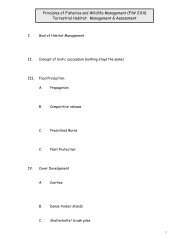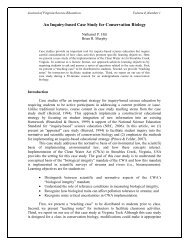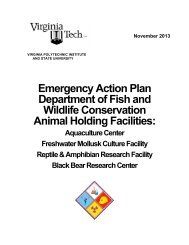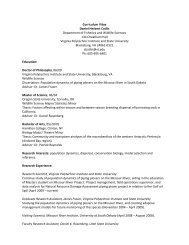An International Journal of Ecology, Evolution and Environment
An International Journal of Ecology, Evolution and Environment
An International Journal of Ecology, Evolution and Environment
Create successful ePaper yourself
Turn your PDF publications into a flip-book with our unique Google optimized e-Paper software.
2010 JONES ET AL.: BIRDWING PEARLYMUSSEL LIFE HISTORY AND DEMOGRAPHY 337controlled, water-recirculating artificial streams with gravel-filled bottoms at the FreshwaterMollusk Conservation Center at Virginia Polytechnic Institute <strong>and</strong> State University,Blacksburg, to study life history. Depending on when mussels were collected, watertemperatures in the artificial streams were set at 15 to 20 C to mimic ambient rivertemperatures.The number <strong>of</strong> glochidia (fecundity) from 2 females collected in the Clinch River <strong>and</strong> 6females collected in the Duck River was estimated by flushing glochidia from the outer gills<strong>of</strong> each female with a hypodermic needle filled with water. All glochidia were counted forsmaller females using a dissecting microscope to determine the number <strong>of</strong> glochidia/female to estimate fecundity. However, for the larger females, sub-samples <strong>of</strong> glochidia werecounted from 1 ml aliquots (n 5 3), <strong>and</strong> fecundity assessed volumetrically. Maturity <strong>of</strong> theglochidia was tested by exposing a small subset (,100) to a dilute salt solution (Zale <strong>and</strong>Neves, 1982). Glochidia were deemed mature when .20% exhibited rapid, sometimesmultiple, snapping responses when exposed to the NaCl solution. Dimensions (length 5anterior to posterior, height 5 dorsal to ventral) <strong>of</strong> 20 glochidia from each female musselwere measured using an ocular micrometer.Live female mussels were held in temperature-controlled (21–22 C) artificial streams forphoto-documentation. This laboratory set-up allowed females to display their mantle-lure<strong>and</strong> for behavioral observations <strong>of</strong> lure movements that were recorded under controlledconditions. All behavioral observations were made during daytime hours. Photographs <strong>of</strong>the mantle-lure were taken using a Nikonos V underwater camera with a 35 mm lens <strong>and</strong>Kodak 200 Ektachrome film.Fish hosts.—Based on preliminary studies conducted by Hill (1986) <strong>and</strong> Watson (1999), wefocused primarily on testing various darter species <strong>and</strong> one species <strong>of</strong> sculpin as potentialhosts. Most <strong>of</strong> the fish were collected from the upper North Fork Holston River, ,1 kmabove Saltville, Smyth County, VA. Black sculpins (Cottus baileyi) were collected from theMiddle Fork Holston River at Atkins, Smyth County, VA. Gilt darters (Percina evides) werecollected from the Powell River, Lee County, VA, at the State Route 833 bridge where Lemioxrimosus was rare. All other fish collection sites had few mussels <strong>and</strong> no birdwingpearlymussels. Fishes were collected using low voltage (200–250 V) electroshocking toensure survival. Common <strong>and</strong> scientific names follow Robins et al. (1991) for fishes <strong>and</strong>Turgeon et al. (1998) for mussels.Methods for infesting fish with mussel glochidia generally followed Zale <strong>and</strong> Neves(1982). A plastic container 29 3 19 3 12 cm deep was used to hold fish during infestation.Fish <strong>of</strong> various species were held simultaneously in ,0.5 L <strong>of</strong> water, <strong>and</strong> glochidia from 1–3females were added to the container. The water in the container was constantly agitated byusing 2 air stones positioned on opposite sides for ,1 h. After infestation, fish wereseparated by species <strong>and</strong> placed in 38-L aquaria without substrate. Fish species were heldseparately at low densities (6–8/aquaria) in a water-recirculating fish-holding system. Thebottoms <strong>of</strong> the aquaria were siphoned every 2 to 3 d until juvenile mussels were firstcollected, <strong>and</strong> every 1 to 2 d thereafter. Juveniles were counted <strong>and</strong> placed in a culture dishwith sediment <strong>and</strong> algae for rearing. Collection <strong>of</strong> mobile juveniles confirmed that theglochidia had transformed on the fish species, <strong>and</strong> that species was a potential natural host<strong>of</strong> Lemiox rimosus.Age <strong>and</strong> growth.—Fresh-dead shells <strong>of</strong> Lemiox rimosus were collected from various locationsin the Clinch <strong>and</strong> Duck rivers, TN between 1998 <strong>and</strong> 2007. Shells <strong>of</strong> various lengths werecollected to best represent the size-class structure <strong>of</strong> the population <strong>of</strong> each river. Thinsections<strong>of</strong> shells were prepared following procedures described by Clark (1980) <strong>and</strong> Neves









